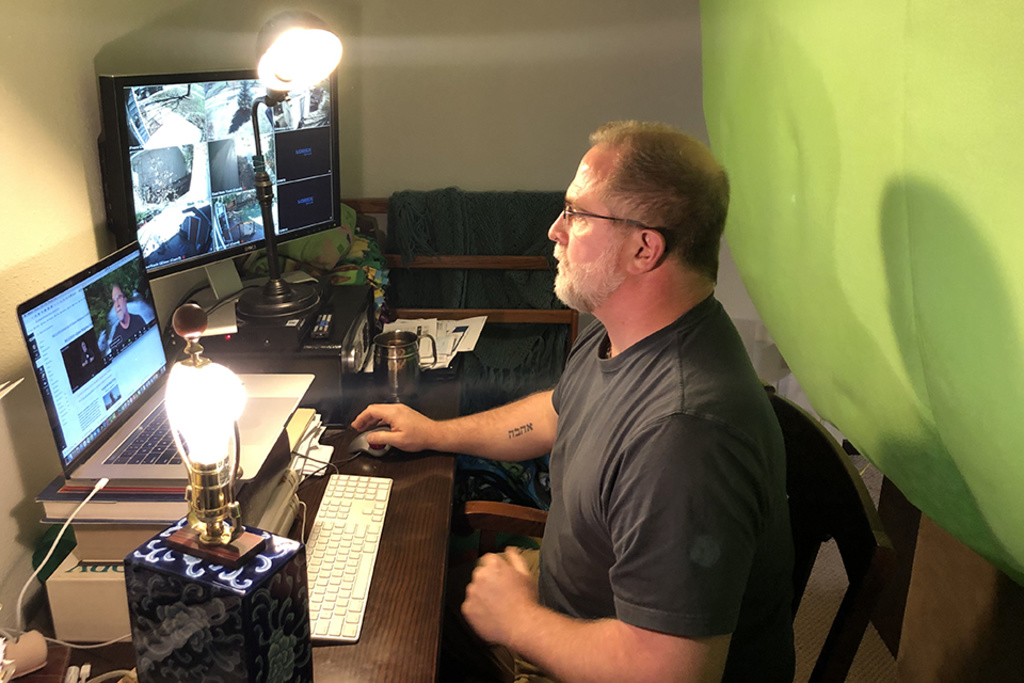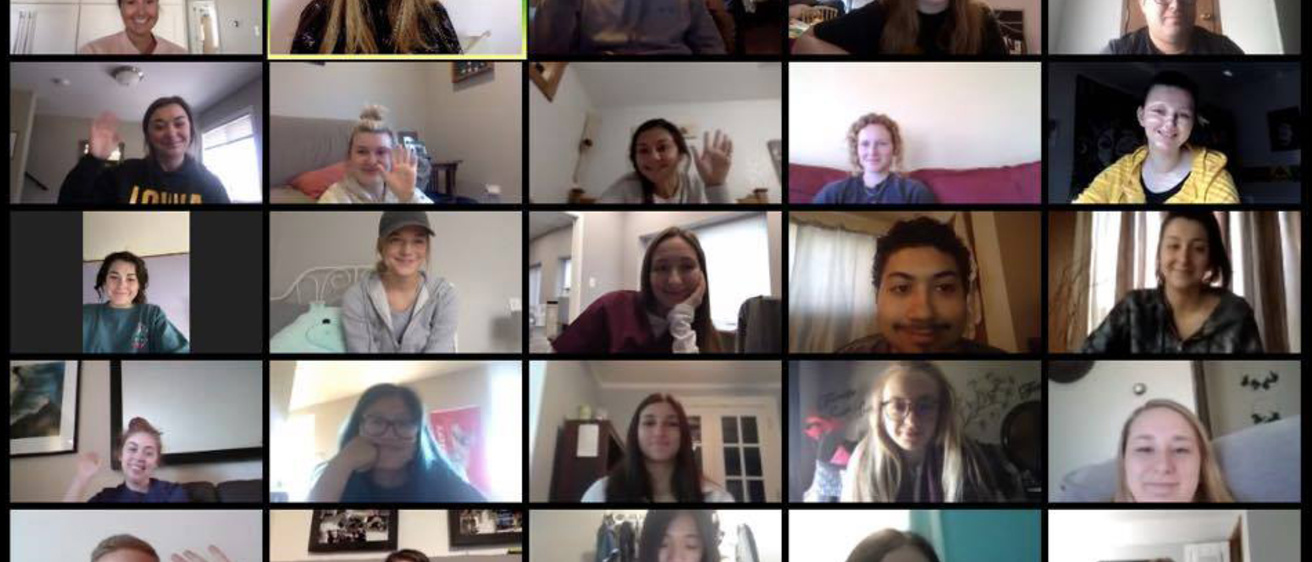“If you’re watching this video, then exactly what we thought might happen has happened. The COVID-19 coronavirus has spread through the nation. But fear not. We anticipated that this might happen. In fact, the University of Iowa, from President Bruce Harreld all the way down, had a plan in place, has been monitoring this situation very closely, and has put tools at the disposal of the faculty to migrate all of our courses from in-person meetings to online courses. I need you to know that you as students did nothing wrong, and the burden is not on you. In fact, you might actually like taking these courses online from your homes. You might find you enjoy this process. Fear not: Everything is going to be fine. Let me run you through a couple of the changes we have to make together to make sure this class runs smoothly the rest of the semester.”
This introduction from a video message by Robert Cargill, University of Iowa associate professor of classics and religious studies, to his students was made to reassure them about the weeks ahead as well as walk them through the changes they can expect from his class for the remainder of the semester.
Keep Learning at Iowa
Students can find resources and tips to prepare for online learning, access course content online, complete activities and assignments, improve study skills and time management, and more.
Click here for help.
Keep Teaching at Iowa
Faculty can find resources to help solve technology problems, communicate with and support students, facilitate activities and assignments, and more.
Click here for help.
Distance and Online Education at Iowa
Iowa combines leading-edge technology and support with nationally recognized faculty to provide the best education experience possible.
Learn more.
Coronavirus updates
Stay current with campus COVID-19 information.
“I thought it was important to go directly to them instead of simply putting up a new syllabus and assignments online and sending them an email,” Cargill says.
Due to the ongoing COVID-19 pandemic, students returned March 30 to classes not on campus but at their homes on their computers or other electronic devices. Faculty and staff across campus have spent the past weeks migrating nearly all courses to a virtual environment.
The University of Iowa is no stranger to online learning. It is one of the largest deliverers of online education, ranking in the top 50 in the nation and No. 4 among its peers. The university offered 650 online courses generating 135,086 semester hours during the 2018–19 academic year.
This extensive experience will ensure Iowa students continue to receive an education that remains among the best in the nation.
The Office of Distance and Online Education works with nearly all colleges on campus to support online education with a staff that includes instructional designers, course coordinators, and media specialists.
“We are all working tirelessly to support faculty as they move their courses online, providing pedagogical and administrative support,” says Anne Zalenski, associate dean, University College, Distance and Online Education. “This allows faculty to focus on their teaching and students on their learning, regardless of the modality.”
Maggie Jesse, senior director for the Office of Teaching, Learning, and Technology, says Iowa is ahead of the curve in many areas. In a recent list of lessons learned from across the country, another university advised that every course have a website set up in the campus learning system.
“We’ve been doing that since 2005,” Jesse says. “Every course in the registrar database gets an ICON site. The faculty member can decide if they activate it or not, but they all exist. The structure is all there because of decisions we made 15 years ago.”
She says the campus also has worked hard in the past 15 years to integrate its systems.
“Students only have to worry about that one place to go, which is ICON,” Jesse says. “All the course tools are there. They can find their Zoom links and lecture recordings, have discussions with their peers, in some cases access their textbooks. Those decisions and that work have set us up so well for right now.”
The Office of Distance and Online Education and the Office of Teaching, Learning, and Technology have partnered with faculty and students to make the transition online. One of the first tasks they proactively teamed up on was the Keep Learning at Iowa and Keep Teaching at Iowa websites. Aimed at students and faculty, respectively, these sites offer resources to prepare for online learning and teaching, and a help desk to answer questions.
The offices also have hosted faculty training sessions for tools such as Zoom and testing software Proctorio.
“We have a saying that there is no successful student without a successful faculty member,” Jesse says. “We are working hard to keep faculty members successful in the virtual classroom.”
Faculty members also are stepping up to help their colleagues. Cargill has designed and taught online classes in the past, so he was well-positioned to help others learn.
“We’re really pulling together as a university,” Cargill says. “We’ve all been very busy, but it’s all coming together, and I think we’ll be in pretty good shape going forward.”
Cargill, who was hired in 2011 as part of the university’s Public Humanities in a Digital World initiative, credits the University of Iowa’s relatively smooth transition to online learning to its investment in the digital humanities over the past decade.
“When you invest in research and you invest in the future, you don’t always know how that’s going to pay off specifically,” Cargill says. “But because of the foresight that the university had to invest in the digital humanities, we were that much more prepared to have the resources available to transition to online teaching.”
Not all students are new to taking a class online. While the university’s more than 650 traditionally online courses support 38 degrees and certificates available online for students who are not in Iowa City, more than 50% of the enrollments in online courses are actually students who are on campus.
“These students find that online courses help them maintain progress toward their degrees either by taking courses during the summer or helping them manage busy work and class schedules,” Zalenski says.
While some problems remain to be solved, including questions about how to administer some tests fairly and equitably, Jesse is excited by the creativity emerging, especially in courses that put less emphasis on lectures.
“I think a lot of really cool stuff is going to come out of areas that we might consider almost impossible to move online, such as our performing arts courses and even from courses with traditional hands-on labs,” Jesse says. “Our faculty are thinking creatively about exciting ways to bring students together.”
“Faculty seem to be working together with colleagues here and at other schools to create wonderful solutions,” Zalenski adds.
Faculty and students also may find some unexpected benefits to online learning. Jesse says a faculty member in the College of Dentistry, which resumed classes a week before the rest of campus, noted a higher rate of participation for their class that week.
“Students who had been quiet in the classroom were far more engaged in the online discussions,” Jesse says. “I think we’re going to see more of those stories as people realize the opportunities out there.”
Jesse expects this experience to be a change agent on campus. For example, she says better testing software has been on her strategic plan for a couple years.
“I think faculty will come to us now because they will have discovered ways to do this,” Jesse says. “I think we’ll be able to have a whole new conversation about how we do assessments that wasn’t possible until people understood the gaps and saw what the opportunities were.”

Cargill also sees silver linings in the current situation.
“We might find that students and faculty learn a little more about the benefits of teaching and learning online,” Cargill says. “Faculty who may have resisted teaching online before might realize, ‘Yeah, this actually works quite well. I might do this more in the future.’ That, in turn, allows the University of Iowa to increase its reach in the state and nationally. We can offer courses to individuals who wouldn’t normally be able to take them because they can’t come to Iowa City.
“As for students, they might now be more willing to take an online course when they weren’t necessarily comfortable doing it before. For all the negative things that come out of this, those might be some positives.”
Patience is going to be necessary in the coming weeks, both Cargill and Jesse say.
“Our departmental executive officer in classics, Craig Gibson, is encouraging us to be forgiving and to be patient,” Cargill says. “We can’t expect to do all the things we would normally do. We can’t cover all of the material we had hoped, and we must manage student expectations. If we’re more forgiving with the students and we ask them to be patient with us, we’ll all get through this together.”
“Students are anxious. Faculty are anxious too,” Jesse says. “We are on a bumpy ride together, and we have to be patient. We have to provide people with some grace and some space. The institution will have to be flexible with students and they with us. Our No. 1 concern is people’s health. We want our students to stay healthy, and we want our faculty and staff to stay healthy.
“Everyone is trying to do their best. Faculty are doing their best. Students are doing their best. If something doesn’t work, let us know so we can fix it. There are lots of people here who want to help.”
